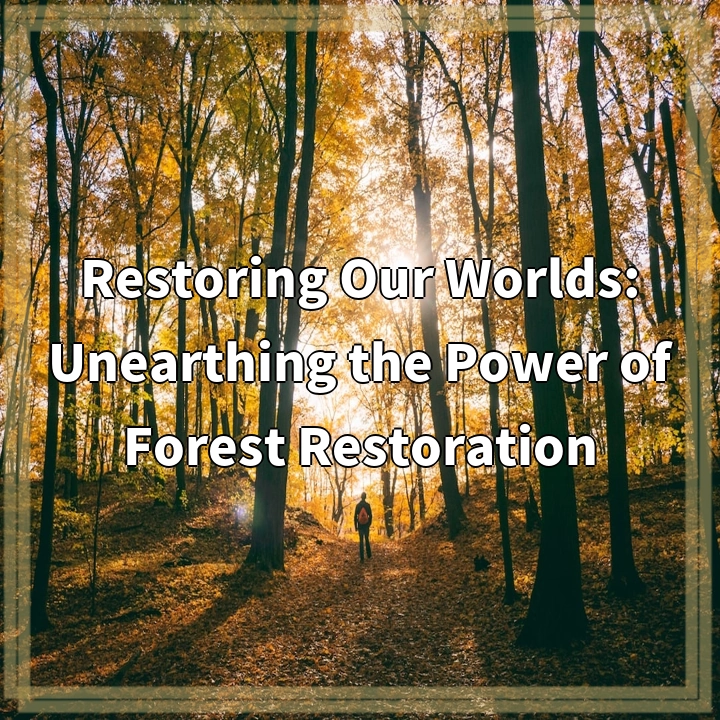
What is Forest Restoration?
Forest restoration is the deliberate and planned process of regenerating and reviving damaged or degraded forests. It involves the reestablishment or enhancement of forest ecosystems, with the goal of improving biodiversity, ecological functions, and community well-being. This proactive approach seeks to reverse the negative impacts of human activities such as deforestation, unsustainable logging, wildfire, and climate change.
Real-World Problems Associated with Forest Restoration
1. Deforestation and Loss of Biodiversity
Deforestation remains one of the most significant threats to forests worldwide. The conversion of forested lands into agricultural fields, urban areas, or commercial plantations results in the loss of habitat for countless plant and animal species. Restoring forests helps combat this problem by creating suitable environments for various organisms to thrive and promoting biodiversity.
2. Degraded Ecosystem Services
Forest ecosystems provide vital services, such as carbon sequestration, water regulation, soil erosion control, and provision of timber and non-timber forest products. Degraded forests struggle to perform these functions effectively, leading to imbalances in climate patterns, increased vulnerability to natural disasters, and diminished livelihood opportunities for local communities. Forest restoration aims to enhance these ecosystem services and restore their benefits to both humans and nature.
3. Climate Change Mitigation
Forests play a crucial role in mitigating climate change by absorbing and storing carbon dioxide (CO2) from the atmosphere. However, deforestation and forest degradation release substantial amounts of CO2, contributing to global warming. By restoring forests, we can sequester more carbon, helping to offset greenhouse gas emissions and mitigate the impacts of climate change.
4. Land Degradation and Desertification
In many regions, land degradation and desertification have left once-rich ecosystems barren and unproductive. Affected areas experience decreased soil fertility, reduced water availability, and increased vulnerability to drought. Forest restoration techniques, such as afforestation and reforestation, can help reclaim degraded lands, improve soil quality, and prevent further desertification.
5. Socioeconomic Impacts on Local Communities
The destruction and degradation of forests often have profound social and economic impacts on local communities that depend on forest resources for their livelihoods. Forest restoration projects can provide employment opportunities, support sustainable livelihoods, and enhance community resilience, thus addressing some of the socio-economic challenges associated with deforestation.
By acknowledging these real-world problems and actively engaging in forest restoration initiatives, we can restore the health, resilience, and vitality of our forests while protecting and preserving our precious natural heritage for future generations.

Solutions for Forest Restoration
1. Reforestation and Afforestation
Reforestation involves replanting trees in areas that have been deforested or where forests have been severely degraded. Afforestation involves creating new forests in areas that were previously without trees. These interventions help replenish tree cover, restore biodiversity, and enhance ecosystem services.
2. Ecological Restoration
Ecological restoration focuses on creating self-sustaining ecosystems that resemble the structure, composition, and functioning of the original forest. This approach involves both natural processes and targeted interventions to recover ecological balance and promote resilience.
3. Community Engagement and Local Participation
Forestry projects that involve local communities and indigenous peoples tend to have higher success rates. Engaging communities in forest restoration activities not only ensures the inclusion of traditional knowledge and practices but also fosters a sense of stewardship and ownership, leading to long-term sustainability.
4. Sustainable Forest Management
Implementing sustainable forest management practices is essential to prevent future deforestation and degradation. This includes responsible logging, reducing illegal activities, implementing effective policies and regulations, and promoting the use of alternative materials that are less dependent on natural forest resources.
5. International Cooperation and Funding
Addressing the wide-scale restoration of forests requires international cooperation and financial support. Governments, organizations, and individuals must collaborate and invest in forest restoration projects, including funding for research, implementation, and capacity building.
By adopting these solutions, we can work towards regenerating our forests, preserving biodiversity, mitigating climate change, and promoting sustainable development. Forest restoration holds immense potential to reverse the damage and create a healthier and more resilient planet for future generations.















